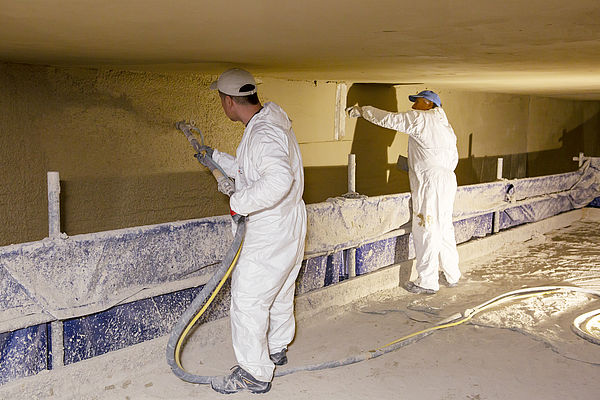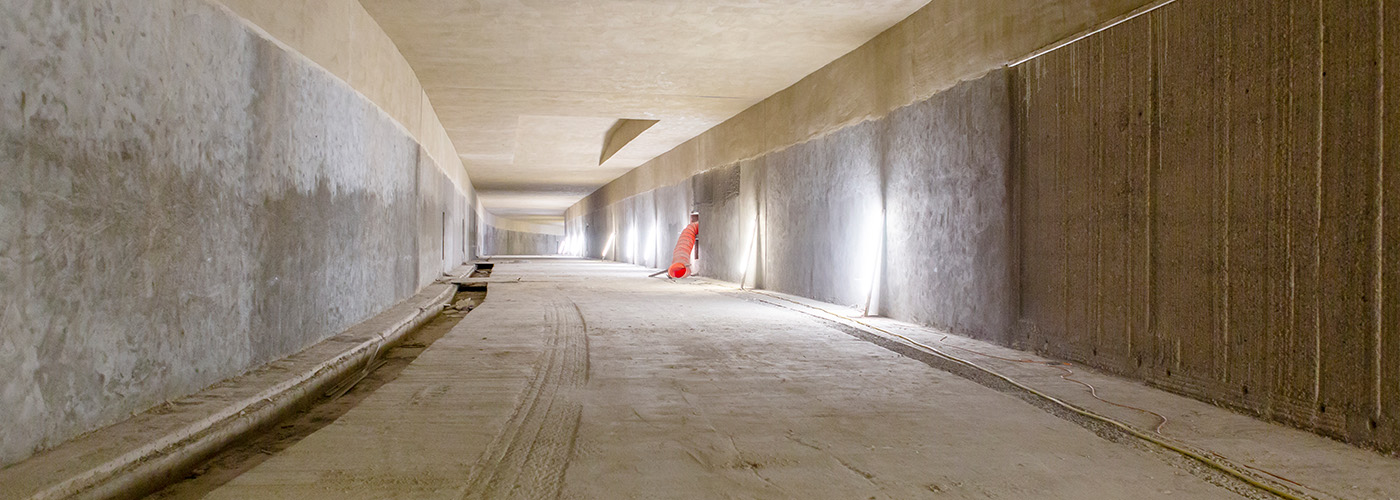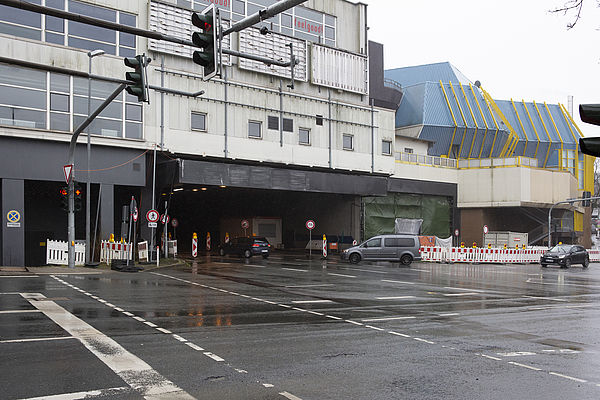Fire protection | Tunnel Lüdenscheid
The two tunnel tubes in Lüdenscheid run directly under the city hall and are heavily used every day. Nevertheless, they had to be renovated to improve fire protection and to install new operating technology. With our maxit ip 160, we made fire protection possible in high gear!
In the two tunnel tubes of the L530 - running directly under Lüdenscheid city hall - fire protection was to be improved and new operating technology installed. This is a massive intervention in the traffic infrastructure of the city of Lüdenscheid, because the L530 is currently very busy in both directions at all times of the day and night. The reason for this is the total closure of the A45 until the completion of the new Rahmede viaduct, which is still under construction. The A45 is currently being diverted through the twin-tube tunnel - a significant additional traffic load. With the help of the fire protection plaster "maxit ip 160", part of the renovation measures could now be accelerated.
Construction began in November 2018. At that time, the client, Straßen.NRW (regional branch South Westphalia) was not yet aware that everything would become much more complicated. The overall planning of the renovation was assigned to the engineering company IMM Maidl & Maidl - Beratende Ingenieure (Bochum). The plan was to renovate the two separate tunnel tubes, each with two lanes, one after the other in order to maintain the flow of traffic. Oncoming traffic was to be diverted via the other tunnel tube in turn. Minimizing this massive traffic disturbance in terms of time was the top priority from the very beginning. Shortly after the start of construction, in May 2019, the suspicion that materials containing asbestos had been used in the construction of the tunnel tubes was confirmed. Asbestos was found in some fillers, furthermore it was used as concrete spacers as well as for permanent formwork. As a result, the tunnel portals were closed, and the planned completion date of the southern tunnel tube for summer 2022 was no longer worth the paper it was written on.
Fire protection plaster? More or less predefined
The processing of the asbestos abatement was assigned to the company Hörnig Bauwerkssanierung (Aschaffenburg), which had already been commissioned with the overall renovation of the tunnel tube - focus on "construction" - and thus had profound knowledge of the tunnel architecture. The pressure of the deadline made this contract a matter for the boss: under guidance of Christopher Sasse, authorized signatory of Hörnig Bauwerkssanierung, a renovation concept was developed under high pressure after taking extensive samples and in close cooperation with the externally commissioned SVB Sachverständigenbüro Dr. Sedat (Essen). In addition to rapid feasibility, the focus was on the ecological compatibility of the building materials and an economically viable long-term solution. Kluge Sanierung GmbH (Duisburg) was commissioned with the asbestos removal itself. Four to five thousand square meters of tunnel ceiling over a length of around 350 meters had to be upgraded to meet today's fire protection requirements. The use of a fire protection plaster was more or less mandatory - not least because of the tunnel geometry. Here, maxit was on the shortlist right from the start, since maxit's product range includes "ip 16" and "ip 160", extremely efficient, tested and standard-compliant fire protection plasters.
Standard and best
Installation of vacuum locks, removal of asbestos-containing materials, decontamination: These are all standard steps in asbestos abatement and, together with derusting of the reinforcements or their complete replacement, were the most extensive work in terms of time. For the complete fire protection upgrade, Straßen.NRW estimated about one year per tunnel tube. Considerable time was made up with the application of the fire protection plaster itself: A good five thousand square meters in just under four to five weeks is an absolute record - for product and processor alike.
Only a few plasters are suitable for tunnel fire protection. According to the Rijkswaterstaat curve, extremely high temperatures of up to 1350 °C are used as a basis for the full fire phase, and the fire resistance duration of up to 3 hours, which is usually demanded, is also a high requirement that is only met by a few fire protection plasters. In Lüdenscheid, there was also a restriction of 350 °C on the maximum temperature on the concrete surface. In close coordination with the commissioned Hörnig Bauwerkssanierung GmbH, the construction managers ultimately decided in favor of the aforementioned "maxit ip 160" fire protection plaster from maxit.

Spraying and smoothing: The fire protection upgrade of the city hall tunnel in Lüdenscheid was a professional team effort.
Top marks for ecology and fire protection
maxit ip 160 is a mineral fire protection plaster with CE marking, consisting of cement, hydrated lime, perlite, vermiculite and aggregates. Vermiculite, which is mainly responsible for the fire protection, is a rather rarely occurring layered silicate from the mineral class of "silicates and germanates". The name refers directly to its curved form as granules. It derives from the Latin word 'vermis': Worm. As a high-performance substitute for asbestos, vermiculite clearly surpasses the latter's fire-protection capacity and at the same time is completely harmless from an ecological point of view. The thickness of the plaster applied is also a decisive factor in limiting the surface temperature at the concrete surface. Here, the ip 160 offers all options: Because starting from a single layer thickness of 5 mm, it can be applied in several layers up to a thickness of 40 mm without any problems. This was also one of the decisive arguments in favor of this plaster system. Up to 40 mm in thickness was applied using the spray plastering method. Sufficient adhesion to the plaster base in accordance with DIN 18550 and DIN 4102-4 is ensured with the ip 160 fire protection plaster by means of a mineral bonding agent, "maxit multi 280. For tunnel constructions, additional regulations apply due to the extremely high fire loads and safety aspects. The guideline for "Protective coatings for increased fire protection for underground structures" issued by the ÖBV (Österreichische Bautechnik Vereinigung) is authoritative - also in Germany. According to this guideline, additional reinforcement must be installed in the ceiling area above a certain layer thickness. In Lüdenscheid, a 50 x 50 mm stainless steel reinforcement was integrated as a plaster base in addition to the bonding bridge.
In one working step
The advantage of the multilayer structure of 40 mm was that with ip 160 the layers stiffen very quickly, so that further layers could be applied on the same day. All renovation sections, including felting, were each completed in one day. The saving of additional set-up times significantly reduced costs and accelerated the work process considerably. These were two essential requirements on the part of the contractor. Not primarily mentioned, but nevertheless indispensable product feature: The ip 160 can be processed very easily and with usual equipment and can be smoothed or felted in a high surface quality. These are all top marks in terms of processing technology, as Managing Director Christoph Störger of the contracted company Hörnig Bauwerkssanierung GmbH expressly emphasizes.
The low weight and mass of ip 160 was particularly advantageous for the fire protection renovation of the tunnel in Lüdenscheid. A low mass significantly reduces the thermal conductivity of the fire protection plaster, while at the same time keeping the weight of the ceiling shell low. In fire protection tests conducted by MFPA Leipzig, concrete equivalent values were determined for this product: With a plaster thickness of 40 millimeters and a fire exposure of 240 minutes, "maxit ip 160" replaces a total of 14.4 centimeters of the significantly heavier concrete. Thin-walled and following the contours, the application of the ip 160 fire protection plaster hardly changes the original room geometries or, in this case, the tunnel cross-section due to the thin shell.
Approved problem solver
All in all, the fire protection renovation of the tunnel once again proves the high performance of maxit ip 160 in fire protection as well as its processing. In Lüdenscheid, the enormously fast stiffening proved to be an absolute problem solver for the necessary acceleration of the renovation measures. In terms of approval, too, all the necessary safeguards are in place: The fire protection plaster can be used in accordance with European Technical Approval ETA-19/0667 and furthermore in accordance with DIN 4102 T4, Section 5.1.4 as per clauses 3-6.

